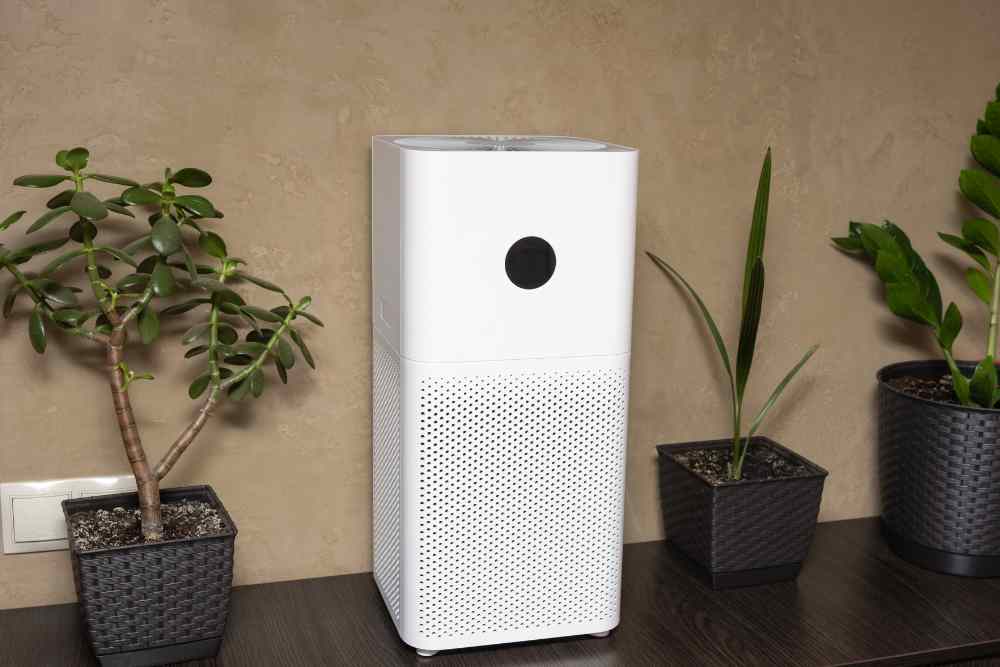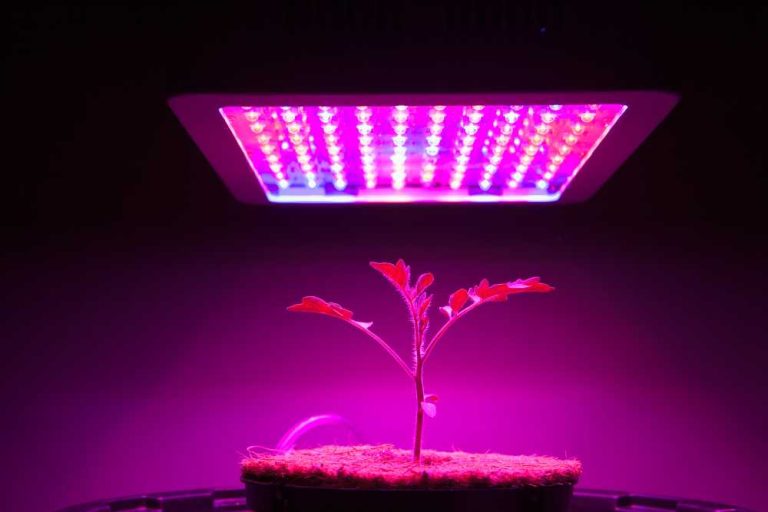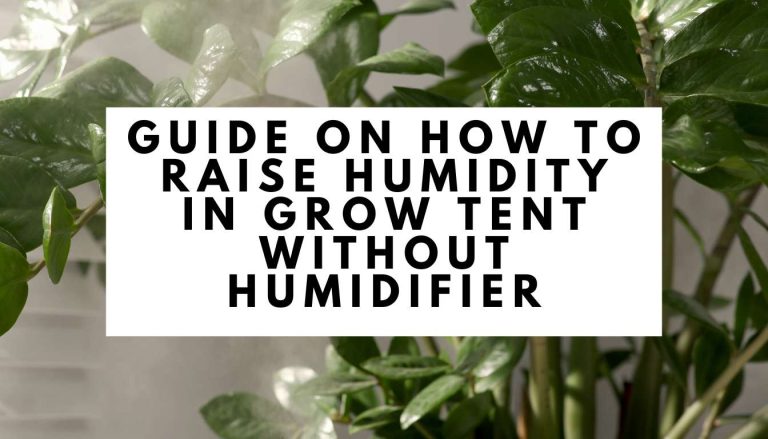Ultimate Guide to Grow Tent Humidification: Tips and Tricks
Knowing how to control humidity in grow tents while growing indoors is essential. Maintaining this metric in the correct range is not always simple, but your plants need a specific moisture content to grow.
We will discuss how to maintain grow tent humidification in your grow tent in this post. Let’s briefly review the growth environment and the importance of the ideal humidity level first. Before proceeding, you must understand the differences between relative and absolute Humidity.
Absolute And Relative Humidity
Absolute and relative Humidity are distinct ways of measuring the amount of water vapor in the atmosphere. To measure Humidity, specific methods are employed, and each method serves a distinct purpose.
Absolute Humidity measures the vapor content or density of the air. It represents the mass of water vapor per kilogram of dry (moisture-free) air in a humid environment. Absolute Humidity is determined by weighing the water vapor in the air. It can be expressed as both kilos and pounds of water vapor. Then, it is considered how much water vapor is present. This density measurement is commonly expressed in grams pounds per cubic foot or per cubic meter. In other words, the density of the water vapor is determined by absolute humidity.
The amount of water vapor in the air divided by the temperature where it reaches saturation is known as relative humidity. It is based on the proportion of saturated water vapor pressure to real water vapor pressure and is given as a percentage.
It represents a percentage of the potential moisture in the atmosphere. Calculating the relative humidity without also knowing the air temperature is impossible. If the amount of water in the air doesn’t change, the relative humidity will decrease as the temperature rises and vice versa.
How Does Humidity Affect Plant Growth?
It’s a positive indication that your plants are healthy and have access to enough water to thrive when humidity is present in a growing area or tent. At various stages of a plant’s life, varying humidity levels are required to be successful (seeding stage, vegetative stage, and blooming stage).
Another thing is humidity is necessary for photosynthesis to take place. The stomata will close, and photosynthesis will cease if the plant loses too much water. If this happens, no more CO2 can be absorbed, even though photosynthesis requires CO2 to continue.
When the air circulation is insufficient, or the relative humidity is too high, or plants cannot drain water or draw nutrients from the soil. If that happens repeatedly, the outcome is that a plant eventually rots. In warm, low-relative-humidity situations, a plant transpires more frequently, reducing the need for a gardener to apply fertilizer.
Why It’s A Bad Idea To Have Low Humidity In Your Grow Tent?
Reduced humidity inside the grow tent has a negative impact on how well the plants grow. Because of this, the plants are unable to grow and eventually die. Additionally, when there is less humidity, plants’ leaves wilt more quickly.
This situation would invite various insects, such as mites, molds, and others, to attack the plants. When there is insufficient Humidity, the roots are the only thing that the surface can absorb. The leaves dry out as a result of the lack of nourishment.
What Is The Ideal Range For Humidity?
The general preference of plants is for a slightly humid climate. However, the ideal range of humidity for a plant range varies depending on the stage of life of the plant. During seedling and early vegetative stages, plants prefer higher moisture levels; over their lifespan, this range will taper off to the lower end. Here are some recommendations for grow tent humidity during various phases:
- Early veg/seedling: 70–75%
- Veg : 50-70%
- Flowers : 40–50%
How To Increase Humidity In Grow Tent?
Maintaining the ideal plant growing environment requires raising the humidity in a grow tent. Since it enables adequate transpiration and nutrient absorption, the right humidity level is crucial for the growth of healthy plants.
However, the humidity levels in a grow tent can stress the plants and perhaps result in disease or lower harvests. There are numerous strategies for increasing humidity in a grow tent :
1. Adding A humidifier
Adding a humidifier is one of the simplest and quickest ways to raise the humidity in the growing area. The fact that they are available in a range of sizes, designs, and features means you can find the humidifier you’re looking for.
The ideal growing environment for indoor plants is created by a grow tent humidifier, designed to continuously release water vapor into the air and raise moisture levels. Make sure your humidifier is functioning correctly and not generating too much Humidity.
Digital types of humidifiers have sensors that activate the humidifier when the humidity rises beyond a predetermined level because humidity will fluctuate often and cannot be maintained on a routine like watering or lighting. The frequent changes in humidity make it inappropriate to use humidifier timers.
A humidifier can be placed inside the grow tent and switched on to continuously add moisture to the air. Although this is a rapid and efficient method of raising humidity levels, using a humidifier for extended periods of time can be costly. Furthermore, it’s crucial to periodically check the humidity levels because an overly humid grow tent can develop mold and other moisture-related issues.
2. Don’t Forget About Grow Lights
Light impacts humidity levels, even though it only has a small impact at different phases of your plants’ growth. Water vapor is released into the atmosphere by plants during the process of photosynthesizing, which turns light energy into glucose and oxygen from carbon dioxide and water.
Transpiration, a process, may cause the grow tent’s humidity level to rise. The degrees of humidity might change depending on how much heat they produce. The air within the grow tent may become warmer and drier if the grow lights produce too much heat, which may reduce humidity.
On the other hand, if the grow lights aren’t producing enough heat, the air within the grow tent can get cooler and more humid, which could increase the humidity levels. It’s critical to maintain the grow tent’s temperature and humidity levels within ranges that are best for your plants. Plant growth can be negatively impacted by excessive or low humidity levels.
3. Mist The Plant Regularly
Misting the plants frequently is a further method to increase humidity in a grow tent. By misting the plants with water, introducing moisture can help the air become more humid.
Plants that benefit from high humidity, such as ferns, orchids, and tropical houseplants, can benefit most from this technique. Nevertheless, it’s crucial to avoid misting the leaves excessively, as this might harm the leaves and promote the development of pathogens that cause disease.
4. Reduce Air Exchange
Increasing humidity can be achieved in a grow tent by reducing air exchange. You can maintain humidity levels in the grow tent by reducing the amount of air exchange.
This can be done by shutting vents or turning down the fan speed, which will slow down air circulation and lessen the quantity of moisture lost to the environment. To avoid over-humidifying the grow tent, you should frequently check the humidity levels and change the fan speed or vents as necessary.
5. Hang A Wet Towel Near Passive Air Holes
One of the simple solutions is to hang a wet towel next to the air intake, which will mist your walls and increase humidity.
This makes it possible for a lot of moisture to be absorbed into the atmosphere. On the other hand, a towel will need to occasionally be wetted because it tends to dry out quickly.
6. Using A Tray Of Water
Another method for increasing humidity in a grow tent is to use a tray of water. This technique is setting up a tray of water close to the plants and letting it evaporate into the air.
The air will become more humid as a result of the evaporation process, which adds moisture to the atmosphere. This approach is simple and economical, but it might not be as efficient as other approaches for increasing humidity in a big grow tent.
7. Lower The Surrounding Temperature
Understanding how to cool down a grow tent to enhance water vapor is common information among indoor gardeners, but it becomes tricky when temperature adjustment is required.
Cold air sinks to the bottom as cold it has a higher density than hot air. A lower temperature typically indicates that the air is moist and contains a significant amount of water vapor. Similar to increasing water vapor, decreasing UV light intensity can do so only if it is sufficient to speed up water evaporation.
8. Combine Mature And Young Plants
It is commonly assumed that larger plants will steal the light, nutrients, and air away from the smaller ones. However, if you start to add plants, especially large ones, the relative humidity in a grow tent will increase since they breathe more and create more relative humidity. The larger plants in your garden respire, releasing carbon dioxide and water vapor, which feeds the smaller plants.
Bigger leaves and more stomata on larger plants allow them to release more water vapor evaporatively. Your plants can then use this water vapor as they grow. The goal is not to overcrowd the larger plants to guarantee that your growing plants get their fair share of air, light, and nutrients.
6 Things To Consider When Choosing A Humidifier
1. Type
Ultrasonic, evaporative, and impeller cool mist humidifiers are the three subtypes. Water is released from ultrasonic models using a vibrating nebulizer. The most significant advantage of this is the absence of a fan, making ultrasonic humidifiers among the quietest. A fan is used to circulate air over a wick in an evaporative humidifier, which collects moisture and releases it into the air.
These humidifiers are efficient at reducing dust production, but they could be noisy depending on the fan level you choose. As they age, they also tend to become louder. Impeller humidifiers produce mist by spinning a disc. Your choice of humidifier will depend on your own preferences, as each type has advantages and disadvantages.
2. Room Size
The size of the space you need to raise the humidity will primarily determine the humidifier you choose. If your goal is to enhance the moisture content in a small space, such as a grow tent, a huge whole-home humidifier won’t be necessary. The first step is to measure your area and get a humidifier that will function well in it.
3. Noise Level
Using a humidifier might be noisy. The noise level won’t be a problem if you want to utilize a humidifier in a grow tent where no one will be present. Making sure the humidifier doesn’t generate a lot of noise, which can annoy you or other family members, is important if you plan to use it in a living space or bedroom where you keep multiple houseplants.
4. Filter Replacement
Humidifiers typically use filters, but not all of them. Although the lifespan of each filter varies depending on the humidifier model, these need to be updated.
While some humidifiers require filter replacement every few weeks, others can go up to six months between replacements. When choosing a humidifier, consider the cost of filters and how frequently they need to be replaced. Cleaning your filter will help it last longer.
5. Cleaning
Humidifiers frequently experience mold growth because of their inherent ability to produce moisture. Your humidifier will require routine cleaning to keep mold spores from circulating through your air. Several humidifiers have this drawback, which is among the more annoying ones.
Some versions must be disassembled weekly to keep them in good condition because they were poorly constructed for cleaning. Purchase a humidifier that is easy to clean. If not, it’ll be forgotten about and kept unused in a kitchen cabinet. Otherwise, it will be left unused in a kitchen cabinet and forgotten.
6. Portability
If you decide to go with a big humidifier, make sure it has wheels so you can relocate it to another room easily if needed. The water container needs to be portable and ideally able to be refilled right at the sink because humidifiers also require frequent refills.
What Is The Best Position To Place The Humidifier?
- A table or shelf in the middle of your grow system is one possible location for your humidifier. It must be at least 2-4 feet above the grow tent floor. This will guarantee that all the crops in the grow room absorb the ideal amount of moisture.
- If you have a small tent, an alternative to conserve room would be to install a humidifier on the ceiling. You must be careful not to install this unit too close to the ceiling when mounting it. This is due to the fact that excessive wetness may cause damage to the grow tent’s roof. The distance from the grow lights should be at least 4 feet.
- The humidifier could be placed outdoors if you are concerned that it will take up a lot of space within your grow tent. To keep the air humid, you just put it next to the intake duct outside your grow chamber. However, use a cool mist humidifier rather than a warm mist machine for the best results.
- In addition, you can position your humidifier in a region of your grow system with the highest airflow. This could be close to the oscillating fan arrangement or exhaust fan in your tent. The humidifier will efficiently distribute moisture throughout your grow area if it is placed close to the venting systems.
- If your growing area doesn’t have many humidifiers, you should put your device in the exact middle of it. This will guarantee that relative humidity levels are distributed as evenly as possible within the grow tent. If your grow room contains numerous units, place them evenly throughout the tent.
- Never place a humidifier next to your plants or the air conditioner. This is so that mold problems don’t arise from excessive water condensation on the soil or leaves. The humidifier must work harder to remove the extra moisture if it is placed close to the air conditioner. Therefore, you should position your unit a few feet away from your plants and air conditioning.
A humidifier is usually best placed inside a grow tent. This is due to the simple setup. Simply set it down on a table or hang it from the ceiling. If the humidifier takes up too much space inside your grow area, you can alternatively move it outside.
Another recommendation is to put it adjacent to the intake duct of your tent. A hose or duct can also be attached to the humidifier’s fan as an alternative. When you run the ducting into your grow area, the humidifier should be at least 3-6 feet away from your plants.
The leaves may burn if you install the system very close to your plants because the humidity in the air is too high. Therefore, the leaves could turn yellow even if the veins are green. In addition, too much moisture may condense on the leaves of your plants, which could result in issues like powdery mildew and mold. This occurs when water remains on the leaves for an extended period. Your crops may eventually wilt and die.
5 Best Humidifiers for Grow Tents
1. Venta LW25 Airwasher 2-in-1 Humidifier and Air Purifier
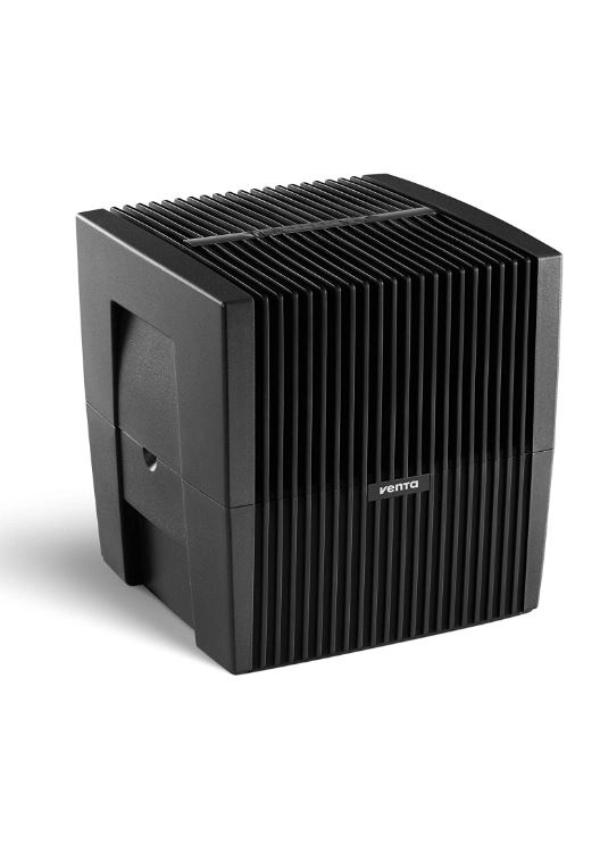
This humidifier cleans the air by removing pollen, dust, and other irritants while adding moisture to it. This unit is perfect for use in a living room or spacious bedroom because it can operate in areas up to 400 square feet.
Its ground-breaking technology purifies the air without needing a filter, reducing upkeep and cost for the client. White dust, which can arise with some humidifiers, is avoided by using a dual humidifier and air purifier. This item also has a 4-gallon capacity, a 10-year warranty, and an automated shut-off.
It operates exceptionally quietly because it doesn’t have a fan to move the air. Users also commented that this item is very easy to clean. In comparison to humidifiers in the classic manner, it only need to be cleaned once every week or two. Additionally, users appreciated that they didn’t need to buy replacement filters regularly.
2. Vornado Evap40 4-Gallon
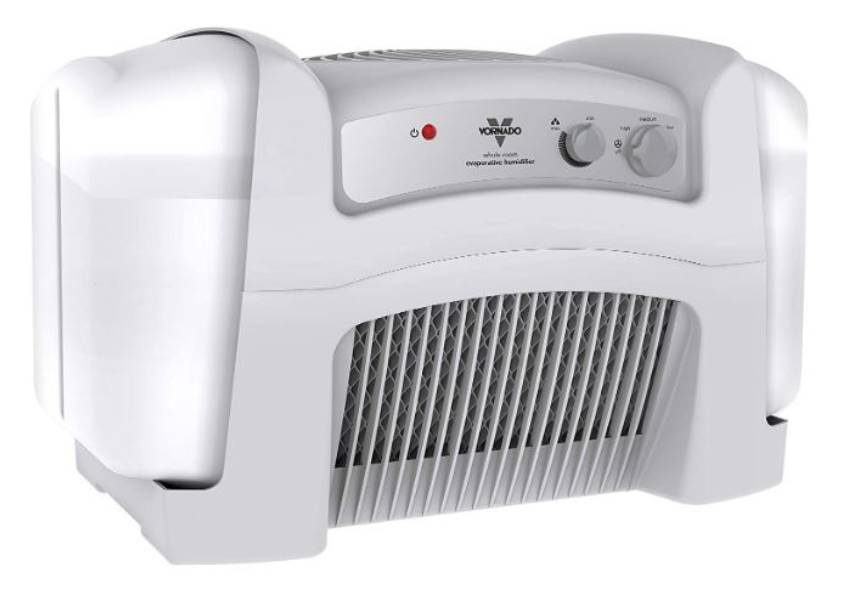
This evaporative humidifier is a fantastic choice for bigger spaces requiring more air movement. While most humidifiers only pump the air out in the same way, the Vornado Evap40 employs its unique “Vortex action” to circulate humidified air throughout your grow tent or grow room.
The 4-gallon water tank is helpful for minimizing the frequency with which you’ll need to replenish the system’s water supply. However, it will take up more water than the typical air humidifier (6 Liter) if you’re using it in a larger location. Additionally, the manufacturer provides a 5-year replacement warranty on this product, which is practically priceless given that other humidifiers may only last 1-3 years before you need to start looking for a replacement.
Additionally, the Evap40 automatically tests the air, detects the humidity level, and modifies its output in response to the environment. Additionally, it includes 3 fan speeds with varying humidity settings: Low – 750 RPM; Medium – 1150 RPM; Maximum – 1600 RPM. This enables you to change the system’s output to produce the desired humidity level for your growing area.
3. AIRCARE Digital Whole-House Pedestal-Style Evaporative Humidifier
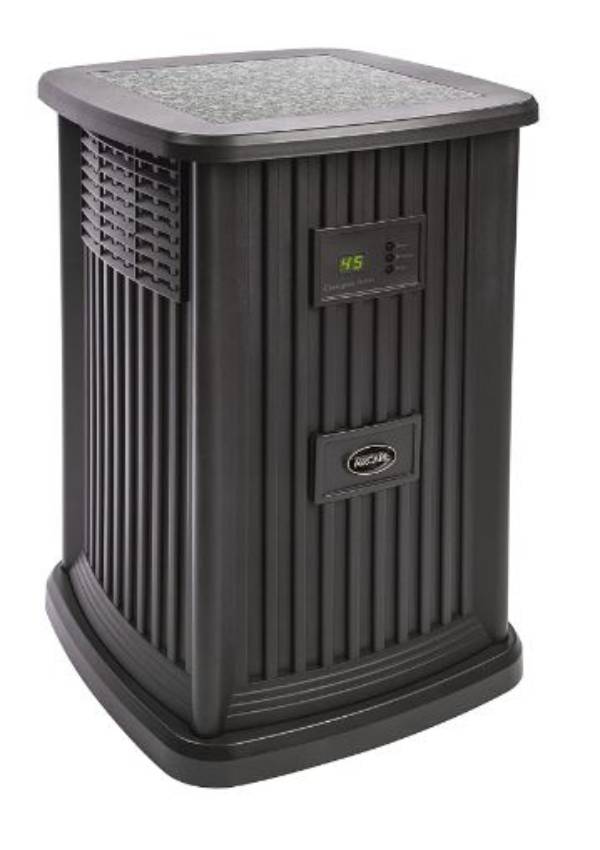
There are 9 fan speeds on this humidifier, which has a 3.5-gallon water capacity. You should refill the water bottle twice daily when operating at a level 3 or 4 setting. This humidifier is intended to raise the humidity levels throughout a whole house up to 2,400 square feet. It comes in a matte graphite color that is midway between gray and black.
The humidifier has a digital display that displays both the ideal and current humidity levels. The device will turn off when the necessary humidity is reached and when the water is all used up. There are many different views among users of this humidifier. The machine may be cleaned and kept operating efficiently with a quick vinegar spray or wipeover of the filter.
4. Vivosun Cool Mist Humidifier
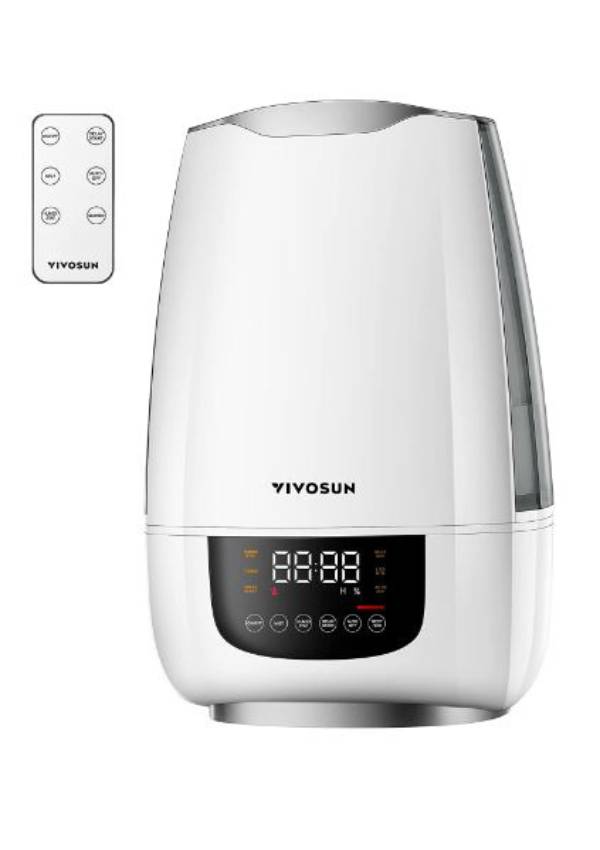
This humidifier technically falls under the hybrid category because it produces cold mist and ultrasonic moisture. As a result, you benefit from both the cold air and the ultrasonic’s quietness.
This humidifier works well in grow tents that are 24 or 33 in size and is best suited for spaces up to 250 square feet. To ensure that the humidity and vapor are moving in the proper direction, you also get a top nozzle that can be spun 360 degrees.
A cleaning brush for the Vivosun humidifier is also included in the base of the humidifier. This is quite helpful when cleaning humidifiers because they can frequently become dirty.
5. LEVOIT Humidifier
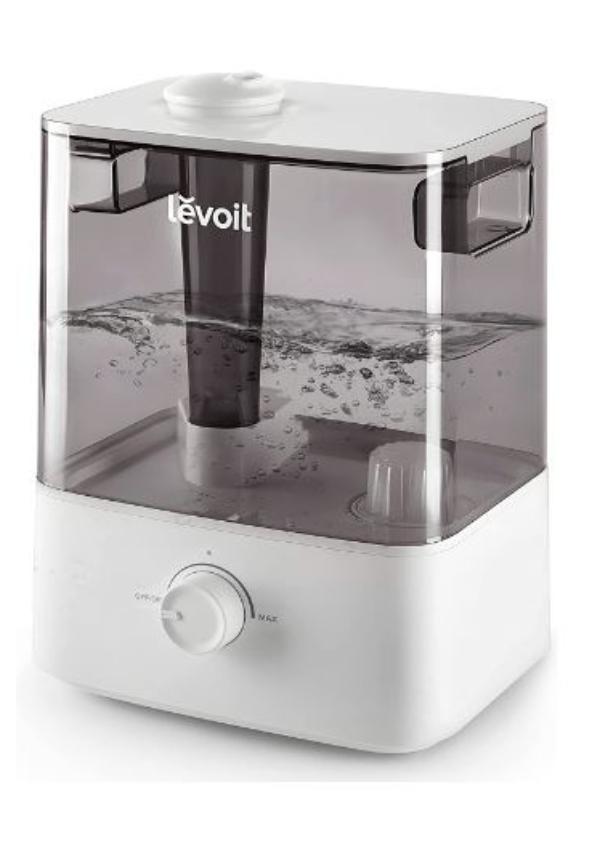
The LEVOIT humidifier has made a lot of plants extremely happy with its 360 rotation and unusually quiet functioning. This machine is great for small to medium-sized grow tents needing extra moisture because it can cover up to 290 square feet and has a run time of up to 24 hours.
The refreshing mist may be directed precisely where you want it to go using the 360-degree adjustable nozzle, then left alone. You won’t have to worry about returning home to a dried-out tank because the humidifier will be turned off automatically when the water level drops too low. You won’t have to be concerned about arriving home to a dried-out tank since the humidifier will turn off automatically when the water level gets too low.
The LEVOIT also includes an integrated soothing night light as a bonus for people who value the ambiance. The main drawback to this gadget is that it only produces cool mist rather than warm mist. Therefore, the LEVOIT might not be the greatest choice if you’re searching for a humidifier that can serve two purposes.
- 15 Ingenious Kitchen Garden Ideas to Cultivate Freshness Right at Home - April 7, 2024
- 10 Top Picks Best Plants for Open Terrarium - April 2, 2024
- 21 Easy and Cheap Walkway Ideas for a Charming Garden - March 31, 2024

